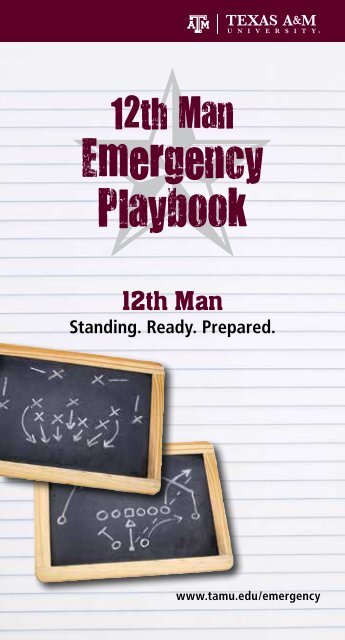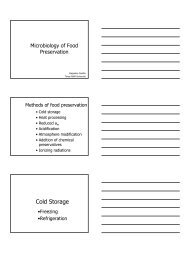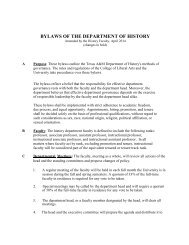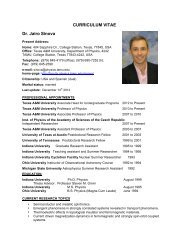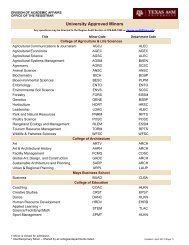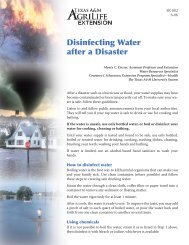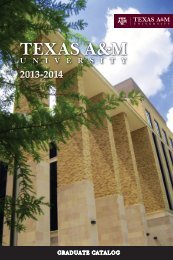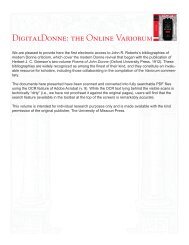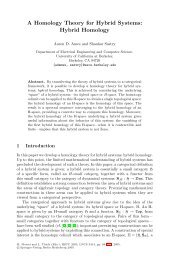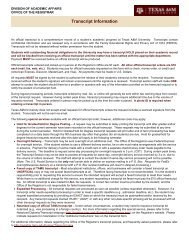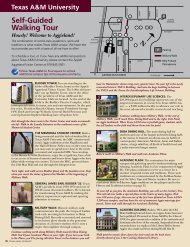12th Man Emergency Playbook - Texas A&M University
12th Man Emergency Playbook - Texas A&M University
12th Man Emergency Playbook - Texas A&M University
- No tags were found...
Create successful ePaper yourself
Turn your PDF publications into a flip-book with our unique Google optimized e-Paper software.
1<strong>12th</strong> <strong>Man</strong><strong>Emergency</strong><strong>Playbook</strong><strong>12th</strong> <strong>Man</strong>Standing. Ready. Prepared.www.tamu.edu/emergency
4<strong>12th</strong> <strong>Man</strong> <strong>Emergency</strong> <strong>Playbook</strong>Introduction 5What is an emergency?An emergency is an unexpected serioussituation demanding immediateaction. These can range from aminor medical emergency to a large-scalenatural disaster. <strong>Emergency</strong> preparednessis the process by which individuals,organizations and governments considerpossible emergencies and take precautions, inadvance, to avoid and/or effectively respondto such emergent circumstances.<strong>Texas</strong> A&M <strong>University</strong> is dedicatedto providing exceptional educationalopportunities while ensuring the safety ofstudents, faculty, staff and visitors. Giventhat emergencies cannot always be avoided,our common first line of defense is our owninitial actions (i.e., those things that we dobefore emergency responders arrive).For more information ora larger print versionof this book visitwww.tamu.edu/emergencyIn an emergency, you should:Be Aware of Your Surroundings. Being aware of whereyou are and what is happening around you can help you tounderstand how information, events and your own actionswill impact your safety and your ability to protect yourself,both now and in the near future.Protect Yourself. Based upon your assessment of thesituation, use your best judgment to protect yourself and,if possible, others.Call for Help. Any emergency service can be summoned bycalling 911 or 9-911 if using a campus phone.Help Others. Once you are safely away from the danger,warn others of the hazard and help if you can withoutputting yourself in danger.Code MaroonCode Maroon is <strong>Texas</strong> A&M <strong>University</strong>’s emergency notificationsystem that gives the <strong>University</strong> the ability to send emergencyinformation advising of imminent danger through multiplechannels including text messages, email, KAMU-FM radio,campus cable television, emergency alert system radios,Twitter, RSS Feeds, and classroom speakers located inbuildings across campus. Following a Code Maroon message,visit emergency.tamu.edu to get important updates andadditional information about the emergency.To receive text message alerts, you must be enrolled in CodeMaroon. Text and email message alerts are only available to<strong>Texas</strong> A&M students, faculty and staff. However, anyone cansign up to receive alerts by subscribing to the Code Maroon RSSfeed or following “TAMUCodeMaroon” on Twitter.To sign up to receive Code Maroon textalerts or learn more about Code Maroon,please visit codemaroon.tamu.edu.
6 <strong>12th</strong> <strong>Man</strong> <strong>Emergency</strong> <strong>Playbook</strong>Section 1: Personal Safety7SECTION 1:Personal SafetyWhile <strong>Texas</strong> A&M <strong>University</strong> has donemuch to make this a safe campus, safetyultimately becomes a personal matter. Howsafe you are depends on your preparationand how much attention you pay to yoursurroundings. This next section describes waysthat you can protect yourself in situationsinvolving:• Active Shooter• Concerning Behavior• Bomb Threat• Suspicious Letter/Package• Suspicious SubstanceActive ShooterAn active shooter is defined as one or more subjects whoactively engage in killing or causing life-threatening injuriesto multiple people in a confined and populated area. Activeshooter situations are dynamic, evolve quickly, and oftenend before law enforcement arrives at the scene. How yourespond to an active shooter will be dictated by the specificcircumstances of the encounter. If you find yourself in anactive shooter situation, try to remain as calm as possibleand use these suggested actions to help you plan a strategyfor survival.For links to Safety Videos on how to survive anactive shooter situation, please visithttps://upd.tamu.edu/SitePages/ShotsFired.aspx.Note: <strong>University</strong> Net ID and password required to view somevideos.RUN. HIDE. FIGHT. ( © 2012 City of Houston)Should you ever find yourself in the middle of an activeshooter incident, your survival may depend on whetheror not you have a plan. The plan doesn't have to becomplicated. There are three things you could do that makea difference: Run. Hide. Fight.PersonalSafety StartsWith You.Remember:Aggies Help Others,Especially OtherAggies.RUN. When an active shooter is in yourvicinity:• If there is an escape path, attempt to evacuate• Evacuate whether others agree to or not• Leave your belongings behind• Help others escape if possible• Prevent others from entering the area• Change to 911 (9-911 from a campus phone) when youare safe
8 <strong>12th</strong> <strong>Man</strong> <strong>Emergency</strong> <strong>Playbook</strong>Section 1: Personal Safety9HIDE. If an evacuation is not possible,find a place to hide.• Lock and/or blockade the door• Silence your cell phone• Hide behind large objects• Remain very quietYour hiding place should:• Be out of the shooter's view• Provide protection if shots are fired in your direction• Not trap or restrict your options for movementFIGHT. As a last resort, and only if your life is indanger:• Attempt to incapacitate the shooter• Act with physical aggression• Improvise weapons• Commit to your actionsArriving law enforcement’s first priority is to engage andstop the shooter as soon as possible. Officers will formteams and immediately proceed to engage the shooter,moving towards the sound of gunfire.When law enforcement arrives:• Remain calm and follow instructions• Keep your hands visible at all times• Avoid pointing or yelling• Know that help for the injured is on its wayConcerning BehaviorOftentimes after a tragedy, people come forward withinformation and observations that, in retrospect, may havesignaled a larger issue. This information when viewedcollectively may be helpful in preventing tragic events andinitiating assistance to an individual. <strong>Texas</strong> A&M <strong>University</strong>is committed to a proactive approach and needs your help.As a member of this <strong>University</strong> community, if youobserve any behavior that is concerning please go to:tellsomebody.tamu.edu and provide detailed informationon the report form. This report goes to members of theSpecial Situations Team. This team is comprised of <strong>University</strong>faculty and staff charged with helping students, faculty andstaff who are exhibiting concerning behavior.In reference to student behavior:Office of the Dean of Student Life(979) 845-3111In reference to staff behavior:Human Resources Employee Assistance Program(979) 845-3711In reference to faculty behavior:Dean of Faculties(979) 845-4274Report SuspiciousBehavior attellsomebody.tamu.edu
10 <strong>12th</strong> <strong>Man</strong> <strong>Emergency</strong> <strong>Playbook</strong>Section 1: Personal Safety11Bomb ThreatA bomb threat is generally defined as a verbal or written threatto detonate an explosive or incendiary device to cause propertydamage, injuries or loss of life whether or not such a deviceactually exists.There are two main reasons someone may callwith a bomb threat:• The person knows of an explosive device that is in placeand wants to minimize injuries• The person wants to create an environment of panic/confusion or to interrupt normal office/building functionsUnfortunately, there is often no way to tell which is themotivation of the caller until after a thorough investigation isconducted. This means that there will always be a response tothe threat by emergency services personnel (police, fire andmedical).If you receive a call on a campus phone:• Immediately after the call is terminated, hang up, obtaina dial tone, dial #91, then hang up (called a trace/trapprocedure)Note: This trap/trace procedure only works for phoneson the TAMU phone system with one of the followingprefixes: 845-XXXX, 847-XXXX, 862-XXXX, and458-XXXX.• Call 911 (9-911 from a campus phone) and the dispatcherwill notify <strong>University</strong> Police• Document the conversation using the Bomb Threat Checklistat rules-saps.tamu.edu/forms/340799M101att.doc• Notify the department head/building proctor• Meet with and assist <strong>University</strong> Police personnel• As directed by <strong>University</strong> Police, help locate/identifysuspicious items• Evacuate the building, as directed• Do not reenter the building until cleared by authorizedpersonnelCampus-wide Bomb ThreatEvacuation ProceduresIn the event that you are asked to evacuate campus due to acampus-wide bomb threat:• Evacuation orders will be disseminated via Code Maroon• Do not activate the building fire alarm system to achieveevacuation• Remain calm but act quickly• Promptly secure equipment, research, etc. in safe shutdowncondition before leaving• Spread the word of the evacuation order to others as youexit the building• Remember to take personal belongings with you(backpacks, briefcases, purses, car keys, personalcomputing devices, etc.)• Pedestrians should exit campus by the shortest route• Exit campus as directed in the Code Maroon message° You may use your vehicle to leave campus unlessdirected otherwise in the Code Maroon message° If possible, Transportation Services will continue tooperate off-campus routes, outbound only. Bus pickuplocations may be altered, changes will be announcedand posted at emergency.tamu.edu° Transportation Services Paratransit can be reached bycalling (979) 845-1971• Do not call 911 (9-911 from a campus phone) unless thereis an immediate, life-threatening emergency• Go to emergency.tamu.edu for regular updates on theemergency situation and information on returning tocampus
12 <strong>12th</strong> <strong>Man</strong> <strong>Emergency</strong> <strong>Playbook</strong>Section 1: Personal Safety13Suspicious Letter or PackageIf you receive a suspicious letter or package:• Do NOT Handle• Don’t shake or bump• Isolate immediately• Don’t open, smell or taste• Treat it as suspect!!• Call 911 (9-911 from campus phone)Common Features of Suspicious Packages:• Are unexpected or from someone unfamiliar to you• Have no return address or a return address that can’t beverified as legitimate• Are marked with restrictive endorsements such as“Personal,” “Confidential,” or “Do not X-ray”• Have protruding wires or aluminum foil, strange odors orstains• Show a city or state in the postmark that doesn’t matchthe return address• Are of unusual weight given their size or are lopsided oroddly shaped• Are marked with threatening language• Have inappropriate or unusual labeling• Have excessive postage or packaging material, such asmasking tape and string• Have misspellings of common words• Are addressed to someone no longer with yourorganization or are otherwise outdated• Have incorrect titles or titles without a name• Are not addressed to a specific person• Have handwritten or poorly typed addressesIf a package or letter is open and/or athreat is identified:For a bomb• Evacuate immediately• Call 911 (9-911 from campus phone)For radiological• Shield yourself from the object• Limit exposure—don’t handle• Evacuate area Call 911 (9-911 from campus phone)For biological or chemical• Isolate—don’t handle• Call 911 (9-911 from campus phone)• Wash your hands thoroughly with soap and waterSuspicious Substance in a Campus Building• Clear and isolate the contaminated area. Do not touch ordisturb anything• Call <strong>University</strong> Police at (979) 845-2345 or911 (9-911 from a campus phone)• Wash your hands with soap and water• Identify individuals who may have been exposed to thematerial• Do not leave premises until dismissed by authoritiesDial 9-911 in an<strong>Emergency</strong> WhenDialing from aCampus Phone.
14 <strong>12th</strong> <strong>Man</strong> <strong>Emergency</strong> <strong>Playbook</strong>Section 2: Medical <strong>Emergency</strong>15SECTION 2:Medical <strong>Emergency</strong>Amedical emergency is an injury or illnessthat is acute and poses an immediatethreat to a person’s life or long-term health.This next section describes ways that youcan protect yourself in situations involving:• First Aid• Poison• RadiationMedical <strong>Emergency</strong> Quick HittersIf an ambulance is needed:• Call 911 (9-911 from a campus phone)• Provide dispatcher with:° Location of emergency° Type of injury, if known° Brief description of injured person(gender, age, etc.)• Render first aid, as trained• Make injured as comfortable as possible• Please complete the appropriate injury reporting formthat can be found at the Human Resources Departmentwebsite at employees.tamu.edu/benefits/leave/workers-comp/forms if incident involves a faculty orstaff memberWhen Dialing 911(9-911 from a campus phone):❚ Stay calm.❚ Tell the dispatcher your location.❚ Answer the questions.❚ Do not hang up until told.❚ Follow all directionsgiven.If an ambulance is not needed:• Render first aid, as trained• Assist with transportation of an employee to theirpersonal physician or a student to the A.P. Beutel HealthCenter, if appropriate• Please complete the appropriate injury reporting formthat can be found at the Human Resources Departmentwebsite at employees.tamu.edu/benefits/leave/workers-comp/forms if incident involves a faculty orstaff member
16 <strong>12th</strong> <strong>Man</strong> <strong>Emergency</strong> <strong>Playbook</strong>Section 2: Medical <strong>Emergency</strong>17First AidFirst Aid is any emergency care or treatment given to anill or injured person before regular medical aid can beadministered. Although some aspects of first aid requiretraining, such as CPR, most first aid can be administered bya lay person using common sense and minimal equipmentfor minor injuries.There are three main aims of first aid:• Preserve life• Prevent further injury• Promote recoveryThe aims are met in the following ways:• Preventing heavy blood loss• Maintaining breathing• Preventing shock• Getting the victim to a physician or <strong>Emergency</strong> MedicalService (EMS)People who provide first aid must remember thefollowing:• Avoid panic• Inspire confidence• Do only what is necessary until professional help isobtainedRemember, the first step in any serious emergency is to dial 911(9-911 from a campus phone). <strong>Emergency</strong> medical dispatcherswill give basic first aid instructions over the phone while theambulance is on its way.PoisonPoison is a substance that through its chemical action cankill, injure or impair an organism. Acute poisoning is exposureto a poison on one occasion or during a short period oftime. Symptoms develop as a result of exposure or in closeproximity of a substance. Poisonous materials can be foundin a variety of household items as well as in laboratoryreagents and chemicals.<strong>Man</strong>y poisons react differently to various treatments, so ifyou suspect a victim has been poisoned through ingestion,inhalation or skin exposure:• Try to determine what the poisoning agent is• Call 911 (9-911 from a campus phone)• Or call Poison Control Center at (800) 222-1222 forspecific first aid instructionsCall Poison ControlCenter at(800) 222-1222 forSpecial First AidInstructions.Avoid Panicand Inspire Confidenceuntil Help Arrives.
18 <strong>12th</strong> <strong>Man</strong> <strong>Emergency</strong> <strong>Playbook</strong>Section 2: Medical <strong>Emergency</strong> 19RadiationRadiation is energy in the form of waves or movingsubatomic particles. It can be classified in two categories:ionizing or non-ionizing. The most common use of the word“radiation” refers to ionizing radiation. Radioactive materialis a physical material that emits ionizing radiation.Ionizing radiation has many practical uses in medicine,research, construction and other areas. However, it alsopresents an external and internal health hazard to humans ifused improperly.For Personnel Injury Involving Radioactive MaterialContamination:• Provide First Aid immediately for serious injuries• Call 911 (9-911 from a campus phone)• Notify Environmental Health and Safety at (979) 862-1111• Monitor the injury. If it is possible to remove thecontaminated clothing without harming the victim, do so.For RadiationContaminationor Spills, call EHS at(979) 862-1111 to reportthe incident.For Radioactive Contamination of Personnel:• Remove and bag all contaminated clothing• Call Environmental Health and Safety at (979) 862-1111to report the incident• Skin contamination should be cleaned using mild soapand tepid water. Use portable survey meter to monitor forremaining contamination. If not free of contamination,rewash and resurvey• Survey for contamination elsewhere on the body as wellas on clothes, shoes, floor, door handles, telephones, etc.• Document the entire incident with either a signed memo/letter or an e-mail from an official university e-mailaccount to EHSFor Radiation Spill or Release:• Stop work and confine the spill immediately using anabsorbent, enclosure, etc.• Call Environmental Health and Safety at (979) 862-1111to report the incident• Warn others of the hazard and isolate the area• Monitor personnel during and after cleanup forcontamination• Collect all used cleanup materials as radioactive wasteand bag all contaminated clothing or cleaning items forremoval by EHS• Commence wipe surveys and decontamination.Perform surveys of surrounding areas to ensure that allcontaminated areas are identified• Document the entire incident with either a signed memo/letter or an e-mail from an official university e-mailaccount to EHS
20 <strong>12th</strong> <strong>Man</strong> <strong>Emergency</strong> <strong>Playbook</strong>Fire/HazMat Quick HittersSection 3: Fire/HazMat21SECTION 3:Fire/HazMatThis next section describes ways thatyou can protect yourself in situationsinvolving:• Evacuation or Shelter-in-Place• Fire• Chemical Spills• Gas LeaksIn case of a fire threat:• Call 911 (9-911 from a campus phone)• If fire is in building, activate nearest fire alarm pull stationand evacuate building• Do not enter building until authorized by emergencypersonnel• Follow instructions from emergency personnelIn case of a HazMat threat:• Call 911 (9-911 from a campus phone) if assistance isrequired• Move away from site of the hazard to a safe location• Warn others in immediate area• Follow instructions from emergency personnelIndividuals needingassistance duringan evacuation areencouraged todevelop personalaction plans andcontacts in thebuilding.Use nearest exitor alternatesafe route. Do NOTuse elevators.
22 <strong>12th</strong> <strong>Man</strong> <strong>Emergency</strong> <strong>Playbook</strong>Section 3: Fire/HazMat 23Evacuation or Shelter-in-PlaceIn some emergency situations, such as flooding or releaseof hazardous materials, emergency responders may orderprotective actions for persons who live or work on campus.Typically, these protective actions are to evacuate to asafer area or to shelter-in-place. It is possible that someemergency scenarios could result in one of these protectiveactions being ordered for one part of campus and the otherprotective action for a different area of campus. When suchactions are warranted, you will be appropriately advised bypolice, fire, safety or university officials via text, email, radioand television stations and the <strong>Emergency</strong> Alert System(EAS), public address systems, loudspeakers, door-to-doornotifications or other appropriate means.Area EvacuationAn evacuation is an organized withdrawal from a buildingor area to reach safe haven. Upon notification to evacuate,quickly:• Dress appropriately for the weather• Take only essentials with you (e.g., eyeglasses,medications, identification and cash/checkbook/creditcards)—do not pack belongings• Turn off unnecessary equipment, computers andappliances• Close the door as you exit your room or office• Follow the directions provided for safe routes ofevacuation• Listen to radio, if available, to monitor emergency status• Do not use your personal vehicle for evacuation unlessspecifically instructed to do so. If cars are used to evacuate,protect against hazardous materials by keepingwindows closed and outside air conditioning systemsturned offIf you need special assistance, contact your ResidentAdvisor, Building Proctor or other appropriate emergencycontact. If these persons are not available, call <strong>University</strong>Police Dispatch at (979) 845-2345 for assistance.For detailed information on a campus-wide evacuation,please see page 11: Campus-wide Bomb ThreatEvacuation Procedures.Shelter-in-PlaceWhen emergency conditions do not warrant or allowevacuation, the safest method to protect individuals may beto take shelter inside a campus building and await furtherinstructions.• Move indoors or remain there—avoid windows and areaswith glass• If available, take a radio or television to the room to trackemergency status• Keep telephone lines free for emergency responders.Do not call 911 for information.If hazardous materials are involved:• Turn off all ventilation systems and close all inlets fromthe outside• Select a room(s) which is easy to seal and, if possible, hasa water supply and access to restrooms• If you smell gas or vapor, hold a wet cloth loosely overyour nose and mouth and breathe through it in as normala fashion as possibleSeek AppropriateShelter Such as SmallInterior Rooms, InteriorHallways or Basements.
24 <strong>12th</strong> <strong>Man</strong> <strong>Emergency</strong> <strong>Playbook</strong>Section 3: Fire/HazMat 25FireA major fire occurring on the <strong>Texas</strong> A&M campus couldinvolve areas where multiple-occupancy residences and/or facilities are clustered closely together, increasing thepossibility of rapid spread of a structural fire. Thus, it isvery important for the campus community to recognize firehazards, practice building evacuations and know what to dowhen the fire alarm sounds.In preparation for a fire:• Plan and practice an escape route• Post emergency numbers near telephones• Get training from Environmental Health and Safety onusing fire extinguishers• Do not store combustible materials in closed areas or neara heat source• Extension cords can be dangerous. Never run themunder carpets, or anywhere they can be pinched under orbehind furniture. Avoid overloading electrical sockets andplugging extension cords together• Keep all electrical appliances away from anything thatcan catch fire. Remember to always turn them off at theend of the day• Pay attention to housekeeping issues. Do not clutterexits, stairways and storage areas with waste paper,empty boxes and other fire hazardsIf there is a fire inside a building:• Activate a fire alarm or pull station• Call 911 (9-911 from a campus phone) and give yourname, building name, address, floor, location and relatedinformation• Evacuate the building using Building EvacuationinstructionsBuilding Evacuation—When the building fire alarms sound:• Immediately evacuate using building emergency planprocedures• Walk to nearest exit/stairwell (close doors behind you)• Do not use the elevators• Proceed to the designated gathering area outsidethe building and report to your Floor Proctor (for aheadcount)• Do not re-enter the building until cleared by authorizedpersonnel• Assist with the evacuation of individuals with specialneedsIf the fire is outside a building:• Call 911 (9-911 from a campus phone) and give yourname, building name, address, floor, location and relatedinformation• Do NOT activate the building fire alarm systemYou can use a portable fire extinguisher if:• You are properly trained (you have had hands-on training)• It is a small, contained fire (e.g., wastebasket)• You can extinguish it within 12 seconds (evacuate if ittakes longer)Have anExit Strategy.
26 <strong>12th</strong> <strong>Man</strong> <strong>Emergency</strong> <strong>Playbook</strong>Section 3: Fire/HazMat27If you are unable to leave the building, youshould create an area of refuge:• Seal the room. Use wet cloth to stuff around cracks infloors and seal up vents to protect against smoke• Do not break windows, unless as a last resort for escape• Stay low under smoke. The freshest air is near the floor.Keep a wet cloth over your nose and mouth; breathethrough your nose only• Signal for help. Call 911 (9-911 from a campus phone) orhang something in the windowAfter a fire:• Give first aid where appropriate. Seriously injured orburned victims should be transported to professionalmedical help immediately• Stay out of damaged buildings. Return to buildings whenlocal fire authorities say it is safe• Look for structural damage• Discard food that has been exposed to heat, smoke orsoot• Do not discard damaged goods until after an inventoryhas been takenDo Not ReturnUntil Building isCleared by theFire Department.Chemical SpillsHazardous materials come in the form of explosives,flammable and combustible substances, poisons andradioactive materials. <strong>Man</strong>y products containing hazardouschemicals are used and stored in homes routinely, and in theuniversity research setting, these materials are handled daily.Hazardous materials in various forms can cause death,serious injury, long-lasting health effects and damage tobuildings, homes and other property.If there is a hazardous materialrelease/chemical spill inside a building:• Isolate and secure the spill area• Warn others in the immediate area• Based upon the hazard, attempt cleanup if trained and ifyou have appropriate personal protective equipment• If assistance is needed, call 911 (9-911 from a campusphone) and give the location and type of material spilled• Evacuate the building if required (use of public addresssystem preferred or use of building fire alarm system)• Meet with and assist emergency response personnelIf there is a hazardous materialrelease/chemical spill outside the building:• Isolate and secure the spill area• Warn others in the immediate area• Based upon the hazard, attempt cleanup if trained andhave appropriate personal protective equipment• If unable to cleanup but conditions do not requireevacuation, contact Environmental Health and Safetyat (979) 862-111• If assistance is needed, call 911 (9-911 from a campusphone) from a safe distance, and give the location andtype of material spilled• Do not wash spilled material into storm drain• Meet with and assist emergency response personnel
28 <strong>12th</strong> <strong>Man</strong> <strong>Emergency</strong> <strong>Playbook</strong>Section 3: Fire/HazMat 29If there is a personnel injury involvingchemical contamination:• Assist with emergency eyewash/shower use,as appropriate• Provide first aid immediately for serious injuries• Call 911 (9-911 from a campus phone) and give thelocation, type of material involved and extent of injuries• Notify Environmental Health and Safety at (979) 862-1111• If it is possible to remove contaminated clothing withoutharming the victim, do so• Obtain a Safety Data Sheet for the material involved.A Safety Data Sheet is a document created by amanufacturer or distributor of a chemical that providesinformation about the contents, characteristics, physicalhazards and health hazards associated with the chemical.For Safety Data Sheet information visit: ehsd.tamu.eduIt is Importantto Report anySuspected Gas LeaksImmediately.Natural Gas canExplode whenExposed to Flameor Sparks.Gas LeaksA gas leak refers to a leak of natural gas, from a pipe orother containment, into any other area where gas should notbe. Although natural gas is by nature colorless and odorless,scents in the form of traces of mercaptans are usually addedto assist in identifying leaks.As natural gas can explode when exposed to flameor sparks, it is important to report any suspected gasleaks immediately.If you smell a gas odor, or if a gas monitoralarm sounds and reads "GAS":• Evacuate and secure area• Warn others in the immediate area• Call the Facilities Services Communications Center at(979) 845-4311 and give your name and the locationof odor• Notify department head/Building Proctor/ResidentAdvisor (RA)• Meet with and assist emergency response personnelIf there is a major leak such as apipeline break:• Call 911 (9-911 from a campus phone) and give thedispatcher your name, location of odor and relatedinformation• Initiate an evacuation of the building or if outside, isolatethe area• Warn others in the immediate area• Prevent source of ignition (cigarettes, electricalequipment, etc.)• Meet with and assist emergency response personnel• Do not reenter building or the evacuation zone untilcleared by authorized personnel
30 <strong>12th</strong> <strong>Man</strong> <strong>Emergency</strong> <strong>Playbook</strong>Severe Weather Quick HittersSection 4: Severe Weather31SECTION 2:Severe WeatherSevere weather is defined as anyaspect of the weather that can pose athreat to life and property. This nextsection describes ways that you can protectyourself in situations involving:• Severe Thunderstorms• Lightning• Tornado• Severe Winter WeatherWarning:Severe WeatherSighted in the Area.Watch:Conditions Favorablefor Developmentof Severe Weather.Severe Weather Quick HittersIf severe weather threatens, you should:• Follow instructions as provided by yourDepartment/<strong>University</strong>• Listen to radio and television for weather updates• Check with media for return-to-work status• Code Maroon will be used to issue information on delays,in multiple formatsWhere to get local weather conditions:Local media outlets will provide updates and information onsevere weather. <strong>Texas</strong> A&M officials will notify local outletsregarding closings or return-to-work situations. (Below aresuggested local channels and radio stations.)• Television (cable/satellite channels may vary)° KBTX° KAMU° KRHD• Radio° WTAW, 1620 AM° KZNE, 1150 AM° KAMU, 90.9 FM° KORA 98.3 FM° KKYS, 104.7 FM• Online° National Weather Service: www.weather.gov
32 <strong>12th</strong> <strong>Man</strong> <strong>Emergency</strong> <strong>Playbook</strong>Section 4: Severe Weather 33Severe ThunderstormsThe typical thunderstorm is relatively small in size andaffects a limited geographic area. Every thunderstormproduces lightning and severe thunderstorms can producehigh winds, hail and/or tornadoes. Heavy rains associatedwith these storms can also cause flooding. All thunderstormsare potentially dangerous.LightningAn average of 300 people are injured and 80 people arekilled each year by lightning in the United States alone. Toprotect the campus community, the <strong>University</strong> has installeda Thor Guard Lightning Prediction System that will sounda warning when atmospheric conditions are favorable forlightning. Horns will sound for approximately 15 secondsand the system lights will continue to flash until the dangeris past. When the danger has passed, the horns will sound3 blasts for 5 seconds each and the lights will turn off.When the warning is sounded:• Cease outdoor activities• Seek shelter inside a building or automobileAvoid:• Open areas; places near water, trees, metal fences,overhead wires or power lines; elevated ground oropen vehicles• Using radios or cellular phones outdoorsTornadoTornados are considered to be one of nature’s most violentstorms. With winds that can reach 300 miles per hour anddamage paths in excess of one mile, this deadly phenomenacan form in a matter of seconds.First, familiarize yourself with the differencesbetween a tornado watch and tornado warning.• Tornado Watch—This means that tornados are possible.You should remain alert for approaching storms, watchthe sky and stay tuned to NOAA Weather Radios,commercial radio or the local news for more information.• Tornado Warning—This means that a tornado has beensighted or indicated by weather radar. You should takeshelter immediately.If a tornado warning has been issued,you should:• Go to the basement or lowest floor of the building• Stay away from exterior walls, doors and windows• Move to interior hallways and small interior rooms(e.g., bathroom, closet, etc.)• Get under a piece of furniture if possible(e.g., sturdy table, desk)• Call 911 (9-911 from a campus phone) if emergencyhelp is neededRemember:• The best source of information during a thunderstorm is yourlocal news, radio stations and any NOAA weather radio• The 30/30 lightning safety rule: Go indoors if, afterseeing lightning, you cannot count to 30 before hearingthunder. Stay indoors for 30 minutes after hearing the lastclap of thunder
34 <strong>12th</strong> <strong>Man</strong> <strong>Emergency</strong> <strong>Playbook</strong>Section 4: Severe Weather 35Once the storm has passed, you should:• Check yourself and those around you for injuries• If you smell gas or hear a hissing sound indoors—open windows and leave the building. Refer to Gas LeakProcedures for more information on page 29.• Monitor your portable or weather radio for instructions oran official "all clear" notice. Radio stations will broadcastwhat to do, the location of emergency shelters, medicalaid stations and the extent of damage• Evacuate damaged buildings. Do not reenter untildeclared safe by authorities• Call 911 (9-911 from a campus phone) only to report alife-threatening emergencyListen to Local Radioand Television forWeather Conditions and<strong>Emergency</strong> Instructions.Severe Winter WeatherWinter storms are known as deceptive killers because mostdeaths are indirectly related to the storm, such as vehicleaccidents caused by winter road conditions, improperuse of heaters, and exposure/hypothermia. Severe winterweather includes freezing temperatures, freezing rain, ice,heavy snow and blizzards. Accumulation of ice or snowcan knock down trees, power lines, and structures causingpower outages, utility disruptions, and communicationinterruptions.What to do during a Winter Storm:• Monitor local weather broadcasts and weather conditions• Stay indoors and minimize travel• If you must travel, drive slowly and increase distancerequired for stopping• Watch for downed trees and power lines• Keep a full fuel tank to prevent ice in the tank andfuel lines• Never use a portable generator or operate unventedfuel-burning appliances in an enclosed space.Code Maroon will be used to issue informationconcerning <strong>University</strong> delays and cancellations.Visitwww.tamu.edu/emergencyOSS1401.0314.7500
<strong>Emergency</strong> Phone NumbersBrazos County 911 District911 (9-911 from a campus phone)Employee Assistance Program(979) 845-3711Environmental Health and Safety(979) 862-1111 (24 hours)Poison Control Center(800) 222-1222Facilities ServicesCommunications Center(979) 845-4311 (24 hours)Student Counseling Service(979) 845-4427<strong>University</strong> EMS(979) 845-1525<strong>University</strong> Police Dispatch(979) 845-2345 (24 hours)Office of Safety and Security1111 Research Parkway4472 TAMUCollege Station, <strong>Texas</strong> 77843-4472(979) 862-8115www.tamu.edu/emergency MARCH 2014


